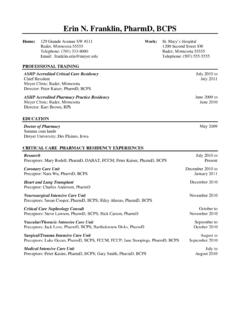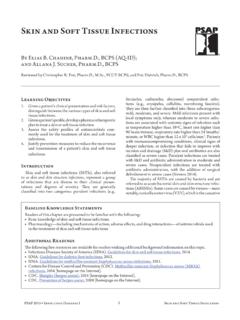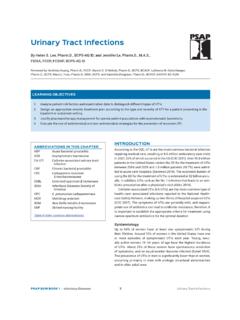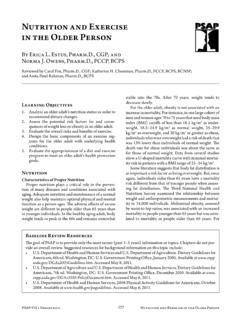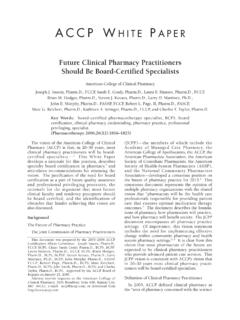Transcription of Cancer Screening and Prevention - ACCP
1 ACSAP 2017 BOOK 1 Oncologic/Hematologic Care7 Cancer Screening and PreventionINTRODUCTIONIn 2016, an estimated 1,685,210 new cancers will be diagnosed, and about 595,690 Americans will die of Cancer (ACS 2016a). Many can-cers can be prevented. Moreover, patients can be screened for can-cer to detect and remove precancerous lesions and/or detect Cancer early, which reduces morbidity and mortality. Cancer Prevention or risk reduction is thought to reduce Cancer mortality. This can be accomplished by (1) avoiding carcinogens or altering the metabo-lism of the carcinogen ( , use of dietary or pharmaceutical che-moprevention); (2) modifying lifestyle or dietary practices that alter Cancer -causing factors or genetic predispositions; (3) using chemo- Prevention ; or (4) using early detection procedures to remove precan-cerous lesions.
2 Prevention can be categorized as primary, secondary, and tertiary. Primary Prevention includes interventions to prevent the development of Cancer ( , avoiding carcinogens, modifying lifestyles, using chemoprevention), whereas secondary Prevention includes interventions leading to the discovery and control of can-cer or precancerous lesions ( , Screening and early detection). Ter-tiary Prevention is the use of treatment once Cancer is diagnosed to reduce the complications and progression or recurrence of IN THIS CHAPTERACOG American Congress of Obstetri-cians and GynecologistsACP American College of PhysiciansACS American Cancer SocietyAUA American Urological SocietyCBE Clinical breast examinationCRC Colorectal cancerDRE Digital rectal examinationFIT Fecal immunochemistry testgFOBT Guaiac-based fecal occult blood testHPV Human papillomavirusLCIS Lobular carcinoma in situNCCN National Comprehensive Cancer NetworkPSA Prostate-specific antigenSERM Selective estrogen receptor modifierUSPSTF Preventive Services Task ForceTable of other common Evaluate the risks and benefits of Cancer Screening and Assess the differences in Cancer Prevention therapies for patients
3 With normal- and high-risk breast Construct a Cancer Prevention plan for a patient at risk of breast, colorectal, human papillomavirus related, or prostate Distinguish between Cancer Screening guideline recommendations for breast, cervical, colorectal, lung, and prostate Design an appropriate Cancer - Screening plan for an individual patient according to Cancer - Screening guidelines and indi-vidual risk by Kellie Jones Weddle, , FCCP, FHOPA, BCOP; Diane M. Erdman, , BCPS, BCACP, CDE, CPPS; and Michelle Musser, , BCPSBy Lisa M. Holle, , FHOPA, BCOPLEARNING OBJECTIVESC ancer Screening and PreventionACSAP 2017 BOOK 1 Oncologic/Hematologic Care8 Cancer Screening and PreventionCancer Prevention and Screening are not without risks, however, and the potential harms must be considered against the potential benefits (Kramer 2004).
4 The risks of Cancer Prevention primarily reside in the potential adverse effects or complications of chemoprevention or early detection removal procedures. Cancer Prevention strategies may also provide a false sense of protection from Cancer because no one preventable strategy is fully protective. Although Cancer Screening is typically noninvasive or minimally invasive, com-plications may occur ( , perforation during colonoscopy). In addition, false test results may lead to anxiety or unnec-essary further testing, which may carry its own risks (false BASELINE KNOWLEDGE STATEMENTSR eaders of this chapter are presumed to be familiar with the following: General knowledge of the most common cancers in the United States Basic understanding of Cancer Prevention and Screening concepts Drug knowledge of agents used for chemoprevention Knowledge of general statistical concepts used to evaluate a clinical testTable of common laboratory reference READINGSThe following free resources have additional back-ground information on this topic: American Cancer Society.)
5 Guidelines for Early Detection of Cancer . Lalkhen AG. Clinical tests: sensitivity and specificity. Cont Ed Anaesth Crit Care Pain 2008;8:221-3. Siegel RL, Miller KD, Jemal A. Cancer statistics, 2016. CA Cancer J Clin 2016;66:7-30. National Cancer Institute. Cancer Prevention . National Cancer Institute. Cancer carcinogens have causally been associated with the development of Cancer , including cigarette/tobacco use, infections, immunosuppression, and radiation therapy (Box 1-1). Other risk factors that have been implicated in Cancer development include diet, obesity, and diabetes. For example, a diet high in fruit and vegetable consumption has been associated with protection against esophageal, mouth, stomach, and possibly lung cancers, whereas a diet high in red and processed meat is associated with an increased risk of developing colorectal and stomach Cancer .
6 Because data are limited and often based on observational studies, no spe-cific dietary recommendations are provided; rather, individ-uals should have a well-balanced diet, much like what one would do to maintain cardiovascular Cancer Screening , Cancer is found using a procedure or blood test at an early stage, often before symptoms appear. Data vary on the number of premature deaths (3% 35%) that are avoided using Screening (NCI 2016). In addition to avoid-ing premature deaths, Screening may reduce Cancer mor-bidity because treatments for early-stage cancers are often better tolerated than those for more advanced-stage can-cers and, in some cases, allow for removal of precancerous lesions, such as with 1-1. Carcinogens Associated with Cancer DevelopmentCigarette/Tobacco Use Acute myelogenous leukemia Bladder Cervix Esophagus Kidney Lung Oral cavity Pancreas StomachInfections Epstein-Barr virus Burkitt lymphoma Helicobacter pylori Gastric Human papillomavirus Anal Cervical Oropharyngeal Penile Vaginal Vulvar Hepatitis B and C LiverImmunosuppression Non-Hodgkin lymphoma Kidney Liver LungRadiation Ionizing radiation Breast Hematologic malignancies ( , leukemia, lymphoma) Lung Thyroid UV radiation Melanoma Nonmelanoma skin cancersInformation from: Engels EA, Pfeiffer RM, Fraumeni JF, et al.
7 Spectrum of Cancer risk among US solid organ transplant recip-ients. JAMA 2011;306:1891-901; and National Cancer Institute. Cancer 2017 BOOK 1 Oncologic/Hematologic Care9 Cancer Screening and Preventionpositive) or falsely reassure an individual who may ignore subsequent signs and symptoms of Cancer , possibly delay-ing diagnosis and treatment (false negative). Overdiagno-sis or lead-time bias is also a concern. For example, some prostate cancers are indolent and not clinically important. Diagnosing a slow-growing lesion may then lead to overtreat-ment and possible morbidity and earlier mortality because of the treatment (overdiagnosis) or have no change at all on mortality (lead-time bias). Lead-time bias can also result in additional morbidity from unneeded treatments and the emo-tional impact on the diagnosis and PREVENTIONA lthough Prevention of Cancer would be ideal, effective pre-vention strategies are currently available for only some can-cers.
8 Cancers for which evidence supports Cancer Prevention strategies in patients include breast Cancer , colorectal can-cer (CRC), human papillomavirus (HPV)-related cancers (anal, cervical, penile, vaginal, vulvar cancers), ovarian Cancer , and prostate Cancer . This chapter focuses on primary preven-tion of Cancer , rather than secondary or tertiary Prevention of CancerMost breast cancers are not related to risk factors other than increasing age and female sex. However, some women are at increased risk because of familial/genetic factors ( , breast Cancer gene 1 or 2 [B R CA1 or BRCA2), age ( , increasing age), ethnicity/race ( , Ashkenazi Jewish descent), lifestyle factors ( , increased BMI, alcohol consumption), reproduc-tive history ( , younger age at menarche, low or nulliparity), and/or disease risks ( , history of lobular carcinoma in situ [LCIS] or radiation to thoracic area at younger than 30) (NCCN 2016a).]
9 In patients with any of these risk factors who are 35 and older, the Gail model is used to determine the individual s 5-year breast Cancer risk (Gail 2001; Spiegelman 2001; Gail 1989). The National Cancer Institute has a freely available risk assessment tool using the Gail model. In women with a cal-culated 5-year relative risk of or higher and a life expec-tancy of 10 years or more or in those with a known genetic predisposition, such as B R CA1 and/or BRCA2 mutation pos-itive, Cancer Prevention options should be offered, together with a risk-benefit discussion. For these women at higher risk, specific Cancer Prevention , also sometimes known as risk reduction strategies, can be used. All women could bene-fit from lifestyle modifications, such as minimal alcohol con-sumption (less than 1 alcoholic drink per day equivalent to 1 oz of liquor, 6 oz of wine, or 8 oz of beer), a healthy well-rounded diet, and regular exercise to minimize obesity and weight gain.
10 The following discussion of breast Cancer pre-vention focuses on primary Prevention only. Although women with a diagnosis of breast Cancer may be at an increased risk of developing a contralateral breast Cancer , the recom-mendations that follow do not apply. Instead, women with a diagnosis of breast Cancer may typically receive breast can-cer treatment that is aimed at reducing the recurrence of can-cer anywhere within the body, including in the contralateral breast. For current, specific recommendations on such ther-apy, the National Comprehensive Cancer Network (NCCN) is a good with the BRCA1- or BRCA2 MutationWomen with the B R CA1 or BRCA2 mutation have an estimated lifetime risk of developing breast Cancer of 56% 84% (Anto-niou 2006; Ford 1998; Struewing 1997).
